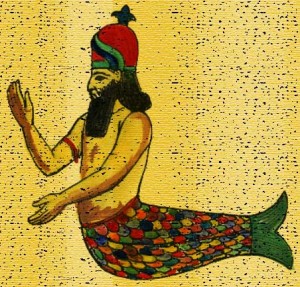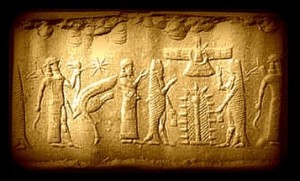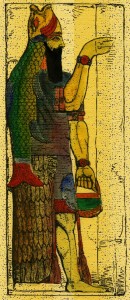Confronting Pseudo-Archaeological Memes Pt 3: Was Dagon of the Philistines a Fish God?
So, I saw this meme once – containing an image of a stone carving purported to be of the priests of the Philistine Dagon, mentioned three times in Scripture. They were supposedly men dressed as fish, and alongside was a painting of a merman who was also supposed to be Dagon, and then a picture of some Catholic priests with their hats and the argument was that Catholicism was just Dagon worship revamped and the pictures proved it.
Just for the record, I am not going to cover how the Catholic officials got those hats. I don’t know, and I don’t really care. I am not a Catholic, and I have never been a Catholic. What I am concerned with is the accurate portrayal of Biblical context, and so I want to analyze the archaeology and show whether it is valid or not. First, let’s talk about Dagon – was he a fish god? This artwork from the Louvre, which is often used to prove that Dagon was a merman, would certainly suggest that he is – but do we have an evidence tying him to this? And doesn’t anyone think it is strange that someone is using a rather modern colored engraving to prove something from antiquity? The original bas relief from Sumeria is to the right, and to the left is the “conjecture” that folks attribute to Dagon.
(credit for the bas relief goes to a href=”http://public-domain.zorger.com” title=”public domain images”>public-domain.zorger.com</a)
Now, let’s look at the actual word Dagon, or dgn, in Semitic languages – in Ugaritic, this word dgn can be translated as grain, and in Hebrew dagon/dagan is also an archaic word meaning grain. This meaning lines up with his association with Ba’al, the Canaanite storm god who also has ties with fertility and the harvest. In Ugaritic literature, Dagon is the father of Ba’al, just as El is the father of Ba’al in Canaanite records. Sanchuniathon, who was a Phoenician author circa 1200 BC (a contemporary of Semiramis, Queen of the Assyrians, according to Porphyry), said, “And Dagon after he discovered grain and the plough, was called Zeus Arotrios.” Arotrios was the designation of Zeus as the ploughman.
Evidently, in the 4th century AD, a tradition popped up that Dagon was a fish god based upon the Hebrew word “dag” which means fish, and this was picked up on in the Middle Ages and even swallowed hook, line and sinker by some of the noted theologians of the day. Artwork was produced, depicting Dagon as a merman, which is now on display at the Louvre. Jewish commentators Rashi and David Kimhi both perpetuated this myth in their writings, which was, in turn, picked up by John Milton in Paradise Lost, who called Dagon a “sea-monster, upward man, and downward fish.”
Now, we see Dagon mentioned three times in Scripture (Jud 16, I Sam 5, I Chron 10), and once in I Maccabees 10, depicting the destruction of the Temple of Dagon, which was surprisingly still in commission at so late a date. Josephus and Philo, as well as Jerome, mention Dagon but no one mentions him as a fish god! Clearly, the “fish-god” myth is late in origin and was sadly picked up by a very popular 17th Century Author and since passed off as archaeological fact. But the preponderance of the evidence of antiquity clearly show Dagon not to be a fish god at all.
Were there fish gods? Yes, of course. Take Oannes for instance, written about in the third century BCE by Babylonian author Berosos, who just happened to be a priest of Bel. Oannes was purported to be the one who gave wisdom to men. This is a depiction of Him in an ancient Mesopotamian Cylinder Seal – clearly meeting Berrosus’ description of him as a god whose whole body was a fish, and under the fish’s head was a man’s head and under the fish’s tail were a man’s feet. And to the right, I have included another colored engraving, depicting a very altered version – looking more like a man in a fish costume and less like a fish god. Creative license, I suppose.
While researching, it has come to my attention that some are equating Oannes with Dagon – but archaeology has completely discounted any chance of that. Oannes was associated with wisdom and the arts, Dagon with grain and sometimes with death – as these two gods are functionally unrelated, the ancient people would never have equated them. Remember that polytheism is all about functional gods – gods who took care of cosmic functions and kept the world from spinning into chaos. Similar gods sometimes merged between cultures, sometimes, but those gods had to share functionalities and Oannes and Dagon shared none. That they were both still worshiped independently at late dates is attested by the existence of the Temple of Dagon in the time of the Maccabees as well as in the mention of Oannes by Berosos in the 3rd century BCE, so there is no reason to even presume a merger.
So who was Dagon? Looks like he was the chief god of the Philistine pantheon, a god associated with grain and with the underworld – not unlike Osiris of Egypt. Be sure to catch part 2 HERE. But he was definitely not a fish god. Here are some of the more accessible resources that I used.
Feliu, Luis The God Dagan in Bronze Age Syria, Brill (2000) – this is the definitive scholarly work on Dagan, it was an AMAZING read which taught me a lot about how ancient gods were worshiped in general.
Van der Toorn, Karel Dictionary of Deities and Demons in the Bible pgs 216-219. This is the must-have book for anyone who wants to speak with authority on the deities that show up in the Bible – over 900 pages of scholarly delight. Like a high-class buffet of polytheism.
Singer, I. (1992). “Towards an Image of Dagan, the God of the Philistines.” Syria 69: 431-450.Itamar Singer – Romanian-Israeli author and historian married to a Ph.D. Egyptologist. Hebrew University of Jerusalem – double bachelor’s degrees in archaeology and geography; Tel Aviv University – Masters, and University of Marburg – Ph.D. with an emphasis in Hittite studies. He was a professor at Tel Aviv University and his focus of interest was the Ancient Near East in the 13th century BC (he had a particular interest in the “sea peoples” who many believe became the ancient Philistines). He was awarded the EMET Prize two years before his death
Stone, Adam, 2013 Ancient Mesopotamian Gods and Goddesses: Dagan – Archaeologist, Ph.D. from Cambridge University, Associate lecturer at Birkbeck College at the University of London where he teaches Sumerian and Akkadian
Leick, Gwendolyn 1991, A Dictionary of Ancient Near Eastern Mythology – Leick has a Ph.D. in Assyriology
So, what I never do is check out Wikipedia first but I have to admit that I went later after studying and whoever wrote up their page didn’t do a bad job! Pretty solid resources 🙂



